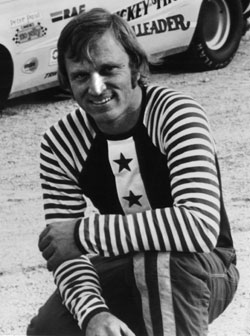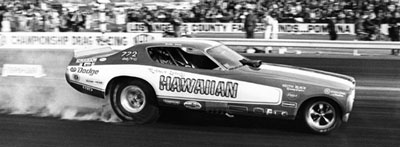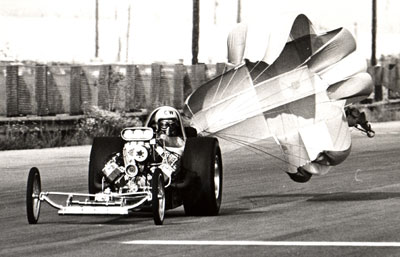

Sorry, Butch
 |
Two days after receiving the news, I still hate myself. Well, maybe that's a bit strong, but I'm certainly very mad at myself.
Tuesday evening, we lost Butch Maas to cancer, and I lost my chance to glean from him his slice of firsthand drag racing history. I'm mad that I lost the race because I kept putting off a call to him because I was swamped with this or under deadline for that, not realizing that Butch's own deadline was approaching faster than I knew. Steve Gibbs and Leigh Buttera (among others) kept telling me I'd better get with it because the light was fading from him, and by the time I did call last week, he wasn't able to take calls anymore. I feel that I not only failed myself but that more importantly I failed him and you. I just always thought there was still time and had circled last week on my calendar as my first come-up-for-air day that I could spend as long on the phone as I needed to to hear Butch tell war stories, which I understand he was very good at. I only spoke once to Butch, sometime last year, and he talked my ear off, but I sadly didn’t take many notes, and it revolved solely around his time behind the wheel of Roland Leong's Hawaiian.
National DRAGSTER did get to tell Butch's story once, 14 long years ago in the Winternationals souvenir issue when the late Chris Martin did a "Where Are They Now?" article on him, which is reprinted in its entirety below, parts of which I used in the obituary I wrote Wednesday.
I've added photos, from our files and some sent by Steve Reyes. It's not the story the way I had hoped to tell it, but it's all that I have. And I hate that. Sorry, Butch.

Yesterday
 (Above) Butch Maas debuted Mickey Thompson's Grand Am with a No. 1 qualifying berth at the 1973 Winternationals. (Below) With "Big Daddy" looking on, Maas wheeled Don Garlits' tricky-handling Wynns-liner at OCIR. (Steve Reyes photos) |
 |
 Maas' biggest win was at the 1971 Winternationals in Roland Leong's Hawaiian. |
Probably no professional driver except Butch Maas can list Don Garlits, Don Prudhomme, and the late Mickey Thompson as employers on his or her driver-for-hire résumé. The Los Angeles-born, San Bernardino-bred Californian drove for those three Hall of Famers and a dozen other top acts in his nearly 20-year career.
In 1970, Maas wheeled Prudhomme's U.S. Nationals-winning dragster to a 6.68 for the No. 1 Top Fuel spot at the inaugural NHRA Supernationals at Ontario Motor Speedway. Three years later, he drove Mickey Thompson's Pontiac Grand Am Funny Car to a low-qualifying 7.18 at the 1973 Winternationals, and that summer, Maas wheeled Garlits' legendary "Jocko" Johnson-designed Top Fuel streamliner at Orange County Int'l Raceway in AHRA Grand American competition.
Taken by themselves, these three accomplishments sound like answers in some trivia quiz, but Maas' career was anything but trivial. At this year's Chief Auto Parts Winternationals, Maas will be celebrating the 25th anniversary of one of his major triumphs, his 1971 Funny Car win in Pomona. At that event, he drove Roland Leong's Hawaiian Dodge Charger to low e.t. and top speed of the class in a final-round 6.93, 212.76 win over Leroy Goldstein and the Ramchargers Dodge Challenger.
Maas began racing while he was in the U.S. Navy, stationed in San Diego. On weekend furloughs, he and his high-school pal, the late 1966 U.S. Nationals Top Fuel champ, Mike Snively, raced each other at Cotton Dragstrip. Eventually, Maas got a chance to drive his first real race car, the Norm Porter-tuned, Dodge-powered, Jerry Howard-owned altered roadster. Though still in the Navy, Maas began to drive other fast cars, including the Scotty's Muffler and the Highland Speed Center roadsters and Sam Rose's Junior Fuel dragster.
Maas got in trouble after he crashed the Rose dragster in San Fernando while racing Danny Ongais' Top Gas dragster. He broke his left arm, which irked his U.S. Navy superiors because military policy discouraged personnel from driving 180-mph nitro dragsters. Neither their disapproval nor his broken arm discouraged Maas.
"While I was in the service, I met Mike Williams, a race fan from Texas, and we went to the 1963 Bakersfield March Meet," Maas recalled. "In Bakersfield, he introduced me to Jim Bush, part owner of the Texas-based Bush & Payne Top Fuel dragster, and I got to drive their dragster at that event. I loved it, and I drove nothing but blown cars ever since."
 Maas driving the Berry Brothers car at Irwindale (Jere Alhadeff photo) |
 Maas at the wheel of the Waters & Maas fuel dragster (Steve Reyes photo) |
 Maas, left, in the winner's circle with car owner Leong, crewmember Dickie Watson, and track manager Steve Evans, right. (Steve Reyes photo) |
 Reyes' photo says it all of the demise of the Mickey Thompson Grand Am at the 1973 Gatornationals. Maas was badly burned but bounced back. |
Maas' driving jobs were many and varied. After leaving the service, he drove the Redd-Nelson-Spratt Savage, Bill Martin's 400 Jr., and Bill Crossley's Crusader Top Fuelers. He drove for Larry Stellings, Tony Waters, the Berry brothers, Bob Creitz and Ed Donovan, Prudhomme, and Thompson.
He also wheeled Leong's Funny Cars, Al Bergler's Motown Shaker, the Rossi & Lisa rear-engine Top Fueler (his only rear-motored experience), and his last ride, Bill Smallwood's Plymouth Satellite Funny Car.
"It's hard to pick a favorite car because most stand out in some way," said Maas. "In 1965, I was one of the first drivers to exceed 200 mph with a Chevy in the Martin car, and in 1967, I set the Irwindale track record at 226.12 mph in Crossley's car. In 1972, I was on the Coca-Cola Cavalcade of Funny Car Stars circuit with the Motown Shaker.
"I did a lot of my touring with the Hawaiian and Motown Shaker cars and learned the match racing trade. Many times, I'd drive all night to make a show and would arrive just in time to put in the oil and get in line.
"We ran every conceivable type of track. In 1971, I drove the Hawaiian and was matched against Richard's Blue Max Mustang in Spartansburg, S.C., for a best-of-three go. When we got there, Tharp and I watched the track manager set a piece of conduit with a light bulb on top on the centerline at the 1,000-foot mark. When we asked what he was doing, he told us not to run a full quarter because we would never get stopped. We walked the track and found he was right. It was a narrow, short track that ran off into the weeds and rocks on the top end.
"Tharp and I agreed we'd split the first two rounds – one of us would shut off and let the other win – then we'd race the 1,000 feet in the third. In the final, we went at it full bore and were dead even going down the track. We ignored the earlier warnings and shot right past those lights and went quarter the full. Neither Tharp nor l got stopped, and we plowed into the weeds and tore up the bodies on both cars. Our two teams were able to repair the cars that night, and I was able to barely make a Delmar, Del., race the next day.'
Oddly, one of Maas' favorite rides was the MIckey Thompson Revelleader Pontiac Grand Am, a car that nearly became a 220-mph coffin. The Buttera-built car met its demise at the 1973 Gatornationals when an engine fire torched it and 50 percent of Maas' body. Maas spent two months in the Shands hospital burn center near Gainesville before being released to recover at home.
After that incident, he briefly drove Garlits' streamliner and the Smallwood Satellite before wrapping up his career in mid-1974.
Today [Ed note:Â Remember, this was written 14 years ago]
Maas lives in Corona, Calif., and works for Salt Lake City-based Ray Bethers Trucking. When he's not wheeling the big rig, he skis, plays golf, and collects Mauser rifles. Like most retired race drivers, he has no regrets about his 15 years in the sport.
"I can't believe anybody in this sport would have had a career saying they hated it," Maas said. "The fire with the Thompson car and the one I had at Edgewater Raceway [in Cleves, Ohio] in 1971 with the Hawaiian were no fun, but they were outweighed by more positive things.
"If I have any regrets, it's that I got out when I did; I'd still Iove to be involved in some way. I'm going to get a little taste of it at the Winternationals this year. I was told I might get to do some color commentary during the Funny Car action."
Butch has left us, but our memories of him will linger. I'm sorry I wasn't able to share his story with you in greater detail. For now, he joins the ever-growing list of racing heroes who have left us but who are remembered on the of the We Did It For Love website. Drop by and take time to remember the others whom Maas will no doubt be racing in drag racing heaven, and in the meantime, be sure to enjoy those who are still with us. Ask them those questions before it's too late.




















































